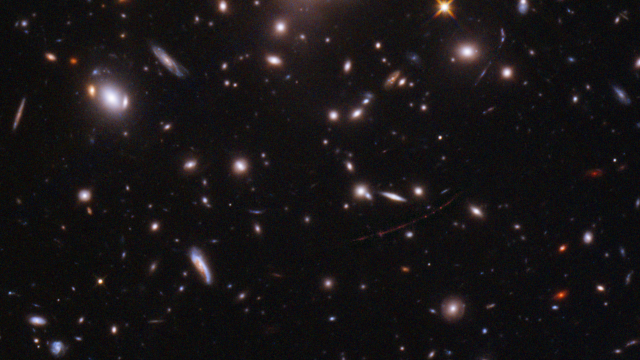The Hubble Space Telescope recently observed the light of a star that existed in the first billion years of the universe. It is the most distant individual star ever seen.
Named Earendel (“morning star” in Old English), the star is at least 3 billion years more ancient than the previous oldest star. Earendel’s light is 12.9 billion years old, meaning its from a time when the universe was just 7% its current age. Details of the discovery were published this week in Nature.
“It was incredible,” said Brian Welch, an astrophysicist at The Johns Hopkins University, in a video call with Gizmodo. “It took a little while to really believe that we were actually seeing what we were seeing.”
Earendel appeared in data collected by Hubble during the RELICS program, which capitalises on gravitational lensing to observe some of the universe’s most ancient stars. Gravitational lensing occurs when light from very distant — which is to say very old — sources is bent around nearer massive objects.
Sometimes, that means photons of light travelling around the interceding object take significantly different amounts of time to reach Earth, as is the case with the Requiem supernova, which was seen in 2016 and is expected to be seen again in 2037.
In their new paper, the team reports that Earendel is magnified by a factor of thousands by a galaxy cluster named WHL0137-08. The red streak captured in Hubble’s image of the star is Earendel’s host galaxy, which is called the Sunrise Arc for its shape, itself a distortion caused by the gravitational lensing.

The arc has a series of bright spots along it; those are star clusters, mirrored by the lensing and stretched along the arc like knots on a daisy chain. Earendel is fortuitously situated along a ripple in spacetime that allowed the star to be detected. The researchers estimate Earendel (as it appears in the 12.9-billion-year-old light) is about 50 times the mass of our Sun and roughly a million times brighter.
Or, rather, it was. Given its mass and age, Welch estimates that the star probably exhausted its fuel and went supernova shortly (which is to say, several million years) after it emitted the photons that are now arriving on Earth. “It has gone supernova by now,” Welch said, “and exploded and spread its guts across the rest of the universe to create those heavier elements that will eventually go into making things like you and me.” Indeed, we are star stuff.
Because Earendel is so ancient, the researchers think the star is probably metal-poor. That’s because it’s only in later generations of stars that heavy elements began to form. Getting more information about the star’s constitution will help researchers place the early gas ball on the Hertzsprung-Russell diagram, a chart that plots the temperature of stars against their brightness. In other words, we may soon be able to put Earendel in a stellar line-up, to know how it compares to stars that formed later in the universe’s history.
Earendel will be an early test for the Webb Space Telescope, a cutting-edge observatory that is set to kick off its scientific operations this summer. Webb was launched in December 2021, and since completing its 2-million-mile journey to its observation point in space has been getting its mirrors aligned, a months-long process that will set the spacecraft up to see the early universe.
Webb will scrutinize Earendel to learn more about the star’s brightness, temperature, and composition. The recent research team was unable to determine if Earendel is a binary — meaning it might have a companion. A Hubble release explains that most massive stars are accompanied by at least one smaller star, so that’s another question that Webb will hopefully sort out.
We may not be around to see Earendel’s ultimate fate — the light from that event won’t arrive here for millions of years — but with Webb, we have a chance at better knowing this ancient star before it’s gone.
